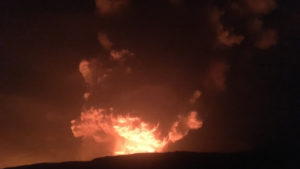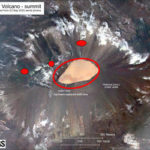Kilauea Volcano is erupting.
The eruption started suddenly Sunday evening around 9:30 p.m., after a swarm of small earthquakes at the summit.
Scientists with Hawaiian Volcano Observatory say multiple fissures opened on the walls of Halemaʻumaʻu crater. The lava cascaded into the summit water lake, boiling off the water and forming a new lava lake at the base of the crater.
The activity is contained within Halemaʻumaʻu crater in Kīlauea caldera, scientists say. One of the fountains within the crater was 165 feet tall.
There was also a 4.4 earthquake at 10:36 p.m.
Hawaiʻi County Civil Defense said trade winds are expected to push any ash toward the southwest. Fallout is likely in the Kaʻu District in Wood Valley, Naʻalehu and Ocean View and encourage residents to stay indoors to avoid exposure to ash.
According to HVO acting Scientist-in-Charge David Phillips, “HVO continues to monitor Kīlauea as the situation is rapidly evolving with this evening’s eruption at the summit of Kīlauea. We will send out further notifications on Kīlauea and other Hawaiian volcanoes as we observe changes.”
Click on attached photo, courtesy USGS, to enlarge slightly. Red spots are the approximate locations of fissure vents feeding lava flowing into the bottom of Halema‘uma‘u crater. The water lake at the base of Halema‘uma‘u crater has been replaced with a growing lava lake. Lava coverage is deeper by 10 m (32 ft) or larger and bigger in extent than the water in this photo (base map is from imagery collected on September 23, 2020). The easternmost vent is currently exhibiting fountains up to approximately 50 m (164 ft) high with minor fountaining on the west side. Occasion blasts of uncertain origin are occurring from lava lake surface.
Photos below courtesy USGS


Below photo courtesy Janet Babb, former Hawaiian Volcano Observatory Public Information Officer, from near Volcano Golf Course

